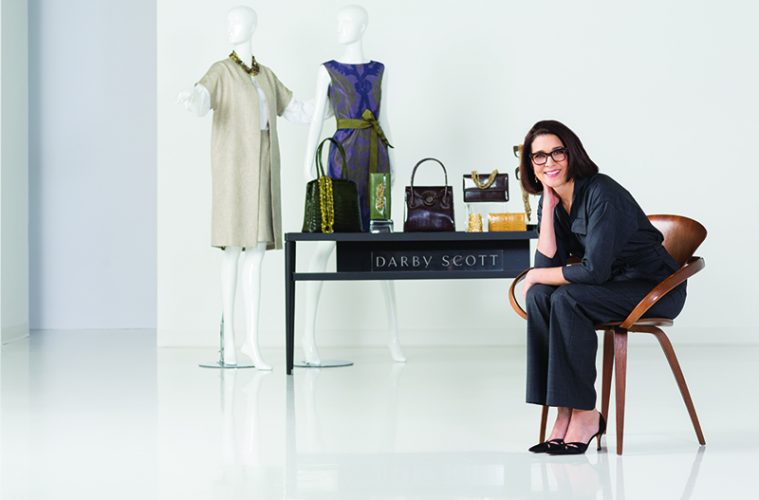When Darby Scott was a preteen in Harvard, Massachusetts, she bought a Vogue pattern and, with a little guidance from her mother, sewed a finely detailed sportswear-style dress, in a batiste floral print, with a beautifully draped hood and full raglan sleeves, its bodice falling gracefully into a bias-cut skirt cinched by a wide Obi sash.
“I think it was my passion for couture clothing I saw on the runways of Europe; the clothing I saw in stores near me seemed rather mundane,” Scott says, reminiscing about those early days, when she was sewing with an ability far beyond her years. Scott’s love of design and color continued to grow, and by college, she was paying her friends with hand-sewn dresses to type her term papers.
Today Scott still spins her fashion magic, swathes of fine fabric and thread floating through her fingers as she tailors a silk suit, creates a new topper coat, or chooses the right stitching for an opal-studded handbag. Now, though, her work is done not on the floor of her parents’ dining room, but in a light-filled studio in an 1850s textile mill in North Andover.
A combination workspace and photography studio, Darby Scott Inc. is filled with clothing samples hanging from cabinet railings and worktables where sketches keep company with fabric swatches and notes. “It’s like a moveable feast,” Scott says of the white-walled space with soaring 30-foot ceilings. She plans eventually to host small informal modeling events and trunk shows here (and in other cities) but for now, the historic redbrick building is Scott’s corporate headquarters, where she creates and markets her clothing and handbags for the Darby Scott Online Boutique and the accompanying e-magazine.
Scott’s clients are women—including Madonna and Queen Noor of Jordan—who love her impeccable designs. Silk-piped seams, perfectly turned out collars and cuffs, and trousers lined in fine silk, are a matter of everyday fact.
The fabrics, mostly purchased in Europe and Asia, are luscious. For spring and summer, Scott is working with a silk-cotton blend that has a subtle sheen and quiet, rich luster. A special tweed, which catches the light with flecks of pink, celadon, and blue, will become a topper coat and skirt. Every fabric, Scott says, must fall and drape properly and look as good after dry cleaning as it did when it came out of the box. “I look for fabrics that will hold,” she says, mentioning a rough-slubbed silk dupioni and an Italian “super 180,” a lightweight wool, that she loves. “I want fabric that has longevity,” she says.
Even clients who are used to Scott’s way with fine fabrics are taken aback by her attention to detail. “I do think I have a bit of a couture sensibility,” Scott says. “When people look at my clothing in person, they are surprised by the finish work.”
This is “old school” design, she says. In the same classic vein, Scott has seamstresses in Manhattan who make samples, which she uses to test fabrics and make prototypes, then has the clothing sewn by American factories—the same ones who manufacturer for such fashion houses as Oscar de la Renta and Carolina Herrera. Her popular handbags are made domestically and in South Africa.
For all the importance of work in Scott’s life, it is life turn that she almost missed. As a teenager, she had her eye on law school. “I didn’t think I would go into fashion,” Scott says. “I thought it was my hobby.” As a student at Smith College, she took “tons of reading and writing courses” to prepare for prelaw. Then one day her brother looked her in the eye and, as Scott recalls, said, ‘“You’re going to work in a job the rest of your life doing something you don’t like? You need to go to New York and go into fashion.’”
So she did. As a new arrival in Manhattan, Scott held positions in merchandising and design at such fashion houses as Karl Lagerfeld and Perry Ellis and eventually became vice president of Women’s Merchandising and Design for the North American division of Aquascutum London. She opened a small studio in Manhattan, selling to exclusive retailers.
In New York, she met and married Matthew Scott. She was eight and a-half months pregnant with their second son when Matthew was killed in a plane crash. Scott took a break from work to be with her sons and then began working on a handbag line. “I thought it would be easier emotionally,” she says of starting a new line. “It was a source of happiness.” Her handbags did very well at luxury retailers, including Bergdorf Goodman and Neiman Marcus. “It kept me going amid all the tragedy,” Scott says. Two years ago she returned to New England.
Today, she is engaged to Dave Kloss, who has two sons and whose wife died of pancreatic cancer. (The couple describe themselves as married and will tie the knot, Scott says, “as soon as we have the time—soon.”) Their relationship is very special, of course. “There’s an appreciation for each other’s past, and an understanding for our boys, what they’ve gone through,” Scott says.
For right now, Scott sells her designs through her online boutique and shows her work on social media sites such as Facebook, Instagram, and Pinterest. She has plans for Scott Men, a new line of wallets, belts, attachés, and furnishings, which will launch this year, and a new leather handbag collection for women.
Every day, she takes in new inspiration: the drape of a new fabric, a glimpse of a color, a bird. “I paint, I sketch, I go to museums,” Scott says. And she muses about her beginnings, as a girl with a sewing machine. “I think I have an inherent feel for design and color,” Scott says. “Sometimes it’s sort of like a painter’s eye.”

